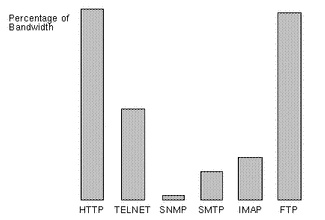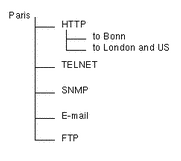Paris
Figure 3-8 Actual Network Use for Paris Site

The network users at the Paris site consider email, file transfer and access to the world wide web to be the most important uses of the network. The actual usage pattern is shown in Figure 3-8.
Using the data on network use and the user input, the network administrator designed the class hierarchy shown in Figure 3-9 and assigned the priorities and percentages of bandwidth shown in Table 3-1.
Figure 3-9 Class Structure for Paris Site
 Table 3-1 Bandwidth Allocation and Priority of Classes on
Paris Server
Table 3-1 Bandwidth Allocation and Priority of Classes on
Paris Server|
Class Description |
Class Name |
Parent Class |
Percentage of Bandwidth Allocated |
Priority |
|---|---|---|---|---|
|
Root |
root |
|
100 |
1 |
|
http to Bonn |
http-bonn |
http |
5 |
3 |
|
http to London or US |
http-lon |
http |
10 |
3 |
|
http to elsewhere |
http |
root |
20 |
5 |
|
telnet |
telnet |
root |
30 |
1 |
|
System monitoring |
snmp |
root |
5 |
1 |
|
|
|
root |
20 |
4 |
|
File transfer |
ftp |
root |
15 |
7 |
|
Default |
default |
root |
5 |
7 |
In batool and in the configuration file, you must specify the bandwidth allocated to a class and all its descendants. For example, the http-bonn and http-lon classes are both child classes of the http class. The http class and its descendants are allocated 20% of the bandwidth, of which the child classes are allocated 5% and 10%.
With this configuration, the bandwidth used by FTP traffic is constrained to 15%, contrasting with the current usage figure of over 30%.
- © 2010, Oracle Corporation and/or its affiliates
